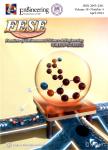Online single particle analysis of chemical composition and mixing state of crop straw burning particles: from laboratory study to field measurement
Online single particle analysis of chemical composition and mixing state of crop straw burning particles: from laboratory study to field measurement作者机构:Shanghai Key Laboratory of Atmospheric Particle Pollution and Prevention Department of Environmental Science and Engineering Fudan University Shanghai 200433 China Division of Math Science and Technology Nova Southeastern University Fort Lauderdale FL 33314 USA Department of Chemistry Carleton College Northfield MN 55057 USA Fudan-Tyndall Center Fudan University Shanghai 200433 China
出 版 物:《Frontiers of Environmental Science & Engineering》 (环境科学与工程前沿(英文))
年 卷 期:2016年第10卷第2期
页 面:244-252页
核心收录:
学科分类:07[理学] 070602[理学-大气物理学与大气环境] 090101[农学-作物栽培学与耕作学] 09[农学] 0706[理学-大气科学] 0901[农学-作物学]
基 金:This work was supported by The National Natural Science Foundation of China (Grant Nos. 21177027 and 41275126) Ministry of Science and Technology of China (2012YQ220113-4) the Science & Technology Commission of Shanghai Municipality (12DJ1400100 14XD 1400600) and the Jiangsu Provincial Collaborative Innovation Center of Climate Change
主 题:crop straw burning particles mixing state,aging process ATOFMS ion markers
摘 要:Fresh straw burning (SB) particles were generated in the laboratory by the combustion of rice straw and corn straw. The chemical composition and mixing state of the fresh SB particles were investigated by an Aerosol Time-of-Flight Mass Spectrometer (ATOFMS). Based on the mass spectral patterns, the SB particles were clustered into four major types: Salt, Organic Carbon (OC), Elemental Carbon (EC), and internally mixed particles of EC and OC (EC-OC). In addition, particles containing ash, polycyclic aromatic hydrocarbons, heavy metals or nicotine were also observed. Physical and chemical changes of the SB particles immediately after the emission were analyzed with highly time-resolved data. During the aging processes, the average particle size increased steadily. Freshly emitted organic compounds were gradu- ally oxidized to more oxygenated compounds in the OC- containing particles. Meanwhile, an important displace- ment reaction (2KCI+ SO24- KzSO4 + 2C1-) was observed. The marker ions for SB particles were optimized and applied to identify the SB particles in the ambient atmosphere. The fluctuation of the number fraction of ambient SB particles sorted by ATOFMS agrees well with that of water soluble K+ measured by an online ion chromatography, demonstrating that the optimized marker ions could be good tracers for SB particles in field measurements.



